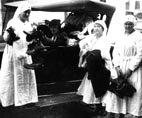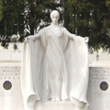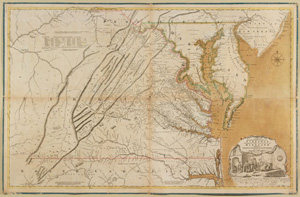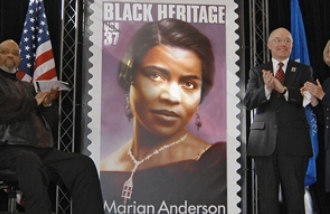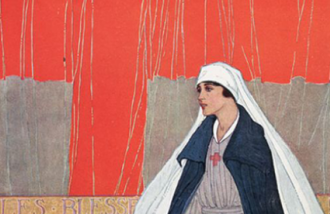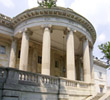WASHINGTON, D.C., April 1, 2002 -The DAR Museum exhibition Forgotten Patriots: African American and American Indian Service in the Revolutionary War is extending its run until August 30, 2003. Forgotten Patriots represents a long-overdue effort to recognize the contributions that African American and American Indian patriots made during the Revolution. Organized by the Daughters of the American Revolution (DAR) Museum and in collaboration with the DAR Library, it illuminates, in many cases for the first time, the varied roles that members of these groups played in our nation's fight for independence. The decision to fight for America against the English was a difficult one for many Americans of all ranks and ethnic backgrounds. For the American Indian tribes, and for enslaved and free African Americans, it was especially problematic. The simple fact that these men and women served at all is a powerful testament to their devotion to our new nation in difficult and uncertain times.
Forgotten Patriots describes the methods used by the DAR to identify these men and women. In doing so it recognizes the work already done by the DAR Genealogy Department and the DAR Library, which is published in African-American and American Indian Patriots of the Revolutionary War. This volume lists, state by state, the names of identified patriots as well as the type of service given to aid the patriotic cause. The exhibition includes the name of all the Forgotten Patriots identified by DAR thus far.
Forgotten Patriots: African American and American Indian Service in the Revolutionary War- through August 31, 2003
A long-overdue effort to recognize the contributions that African American and American Indian patriots made during the Revolution is celebrated in the exhibition Forgotten Patriots: African American and American Indian Service in the Revolutionary War 1775-1783. Organized by the Daughters of the American Revolution (DAR) Museum and in collaboration with the DAR Library, the exhibition will be on view from October 18, 2002 through August 30, 2003 in the DAR Museum's Main Gallery.Forgotten Patriots illuminates, in many cases for the first time, the varied roles that members of these groups played in our nation's fight for independence. The decision to fight for America against the English was a difficult one for many Americans of all ranks and ethnic backgrounds. For the American Indian tribes, and for enslaved and free African Americans, it was especially problematic. The simple fact that these men and women served at all is a powerful testament to their devotion to our new nation in difficult and uncertain times.
According to the "chiefs, sachems, and young men of the River St. John's" when explaining to a British Commanding officer their reason for fighting alongside the Americans in August of 1778, "You know we are Americans; that is our native country."Featured in the exhibition is a portrait of John Neptune, one of the many Penobscot men who fought for the Americans during the American Revolution. Neptune's portrait was painted when he was Lieutenant Governor of the Penobscots. General Washington was especially interested in seeing that the Penobscot Indians joined the patriotic cause. He wrote to Congress on July 4, 1776, that he thought it "advisable to take measures to engage those [Indians] of the Eastward, the St. Johns, Nova Scotia, Penobscot & ca. In our favor& It will prevent our Enemies from securing their friendship, and further, they will be of infinite service, in annoying and harassing them should they ever attempt to penetrate the Country."
Of the Six Nations of the Iroquois confederacy, only two, the Oneidas and the Tuscaroras, chose to fight for the Americans. Washington wrote in 1778, "The Oneidas and Tuscaroras have a particular claim to attention and kindness, for their perseverance and fidelity." Oral history from the Oneidas and Tuscaroras record that the Oneidas brought bushels of corn to General Washington's troops at Valley Forge during the winter of 1778-79. The Oneidas 400-mile walk from their central New York home to Valley Forge with food supplies helped save many of Washington's men from starvation, thus making a difference in the outcome of the war. Between 1807 and 1810 New York State Governor Daniel Tompkins presented Oneida Chief Oskanondonha (also known as Skenandoa) with a silver pipe.
James Armistead Lafayette, a slave from New Kent County, Virginia, served the Marquis de Lafayette near Portsmouth and Yorktown, and as a double agent in British Generals Arnold's and Cornwallis's camps. His portrait, painted in 1824 during the Marquis' triumphant return visit to America, is on view as well as a portrait of Agrippa Hull, a free black who served as an orderly for Polish nobleman General Thaddeus Kosciusko, Washington's chief engineer.
Forgotten Patriots describes the methods used by the DAR to identify these men and women. In doing so it recognizes the work already done by the DAR Genealogy Department and the DAR Library, which is published in African-American and American Indian Patriots of the Revolutionary War. This volume lists, state by state, the names of identified patriots as well as the type of service given to aid the patriotic cause. The exhibition includes the name of all the Forgotten Patriots identified thus far. One such patriot was Garshom Prince, a servant or slave of Robert Durkee. Prince and Durkee were both killed at the Battle of Wyoming. The powder horn Garshom Prince carved and used during the French and Indian War as well as during the Revolution is on display.
What happened to the Forgotten Patriots after the Revolutionary War? Some slipped back into the anonymity of the ages. Others were remembered for their work as ministers, educators, writers or artisans. The Reverend Lemuel Haynes, a minuteman during the war, is depicted in an engraving from the frontispiece of a book. He preached in Massachusetts, Vermont and Connecticut. During the war, he wrote a poem describing the battle of Lexington, as well as an anti-slavery essay, neither of which was published until the twentieth century. His essay, "Liberty Further Extended," took the position that the natural outcome of the Revolution was the abolition of slavery. Many others took the lessons from the Revolution and began working actively for abolition and for the rights of their people.
The legacy of the Forgotten Patriots is carried through to current generations, with photographs and documents from descendants of such men as Nero Hawley, who received his freedom for his service and later became a brick maker, and Charles Lewis, who served both as a soldier and seaman in Virginia and whose descendant is today a member of the Daughters of the American Revolution.


